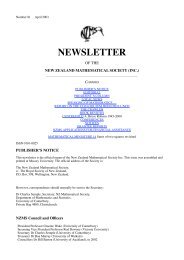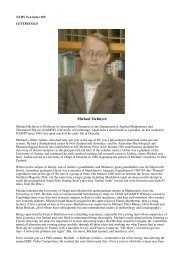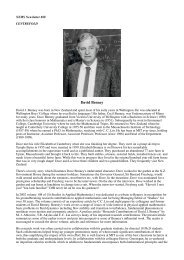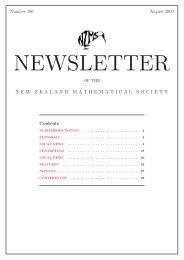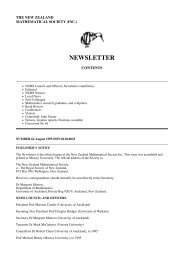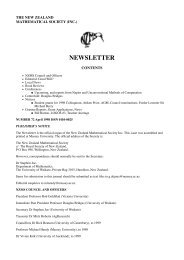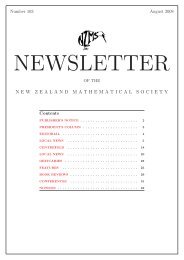newsletter - New Zealand Mathematical Society
newsletter - New Zealand Mathematical Society
newsletter - New Zealand Mathematical Society
You also want an ePaper? Increase the reach of your titles
YUMPU automatically turns print PDFs into web optimized ePapers that Google loves.
There are two chapters on wound healing, dermal and epidermal. Although wound healing is still far from<br />
well understood, Murray argues that studying mathematical models of the process can only help, in<br />
highlighting gaps in our knowledge and suggesting experiments to perform, the ultimate goal being<br />
scarless healing. Also, constructing a model forces one to choose between several possible mechanisms<br />
and to decide what is truly essential, both in terms of variables and processes —an important skill for any<br />
modeller.<br />
Other chapters deal with the growth of brain tumours, pattern formation in neural systems, and wolf pack<br />
territoriality. I was disappointed that the chapter on neural pattern formation has not been updated for this<br />
edition, save for the addition of several pages on "shamanism and rock art'' in which Murray discusses the<br />
apparent similarities between children's scribblings, images on rocks that have been painted by ancient<br />
people—perhaps under the influence of hallucinogenic drugs—and the patterns that occur in some neural<br />
models under the variation of a parameter. While this is interesting, it would have been better to<br />
summarise some of the results in this active field from the past 15 years.<br />
This volume alone is a large book, with more than 800 pages and a similar number of references. There<br />
are 14 chapters, 8 of which are new. These new chapters largely describe the work done by Murray and<br />
his students over the past ten years. As a consequence, this volume sometimes seems a little like a<br />
"collected works''. However, it is a valuable collection of results from different areas of mathematical<br />
biology.<br />
In summary, much of this volume consists of applications of reaction-diffusion equations to biological<br />
systems, with plenty of explanation as to their biological context and subsequent analysis of the<br />
equations. There is much in both volumes to keep an applied mathematician busy. Combined, they would<br />
provide ample material for an advanced course on mathematical modelling, nonlinear dynamics, or<br />
mathematical biology.<br />
References<br />
[1] J. D. Murray. <strong>Mathematical</strong> Biology (2nd, corrected edition). Springer –Verlag, 1993.<br />
Carlo Laing<br />
Massey University, Albany<br />
SET THEORY<br />
The third millennium edition, revised and expanded, by Thomas Jech, Springer Monographs in<br />
Mathematics,<br />
Springer-Verlag, Berlin, 2003, 769 pp, US$129.00. ISBN 3-540-44085-2<br />
Jech's book, "Set theory" (Academic Press, <strong>New</strong> York, 1978) has been a standard reference for over 25<br />
years. This "Third Millennium Edition", not only includes all the materials in the first two editions, but<br />
also covers recent developments of set theory during the last 25 years. We believe that this new version<br />
will become a standard reference on set theory for the next few years.<br />
The book is divided into three parts. Part I, Basic Set Theory, includes the Zermelo-Fraenkel axioms of<br />
set theory, ordinals and cardinals, real numbers, the axiom of choice, fundamentals of combinatorial set<br />
theory, a brief introduction of large cardinals, Borel and analytic sets, and basics of models of set theory.<br />
Everything in this part is derived from scratch. However, the pace is so fast that a beginner should have<br />
read other introductions to set theory before reading this book.<br />
Part II, Advanced Set Theory, contains the important techniques and ideas of modern set theory. This part<br />
can be used as a textbook on set theory for graduate students. Chapter 13 introduces Gödel's theory of<br />
constructible sets, which leads to the consistency proofs for the axiom of choice and the GCH<br />
(generalized continuum hypothesis). Chapter 14 deals with forcing, generic models, Boolean-valued<br />
models, and Cohen's independence results. In Chapters 15 and 16, the author applies forcing to Suislin's<br />
problem, and presents several applications of Martin's Axiom. Chapters 17, 18, 19, 20, 21 provide an<br />
extensive exposition of large cardinals. In Chapter 17, the author shows that while "smaller" large<br />
cardinals (Mahlo, weakly compact) can exist in L, the Gödel's constructible universe, the " bigger" large<br />
cardinals (measurable, Ramsey) cannot. Chapter 18 introduces the concept of 0 # (zero-sharp), and gives<br />
an outline of the proof of Jensen's covering theorem. Chapter 19 is on the generic ultrapowers and inner<br />
models for sequences of measures. Chapter 20 is devoted to the study of the strongly compact cardinals,<br />
the supercompact cardinals and extenders, and also introduces the Woodin cardinals, all of which have<br />
played crucial roles in the theory of large cardinals. In Chapter 21, the author presents several forcing<br />
techniques, like Kunen-Paris forcing, Silver forcing, Prikry forcing, etc., which are used for changing<br />
cofinalities, and for violating Singular Cardinal Hypothesis that use large cardinals. Chapters 22 and 23<br />
are devoted to the results on saturated ideals, precipitousness and saturation of the nonstationary ideals. In




